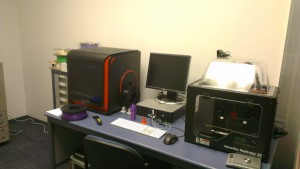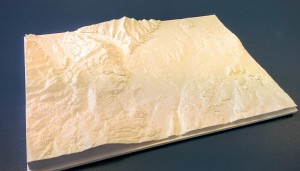At the moment, we’re unable to undertake any more 3D printing jobs. We will update this page when we’re back up and running.
What is 3D Printing?
3D printers use a heated nozzle to melt plastic and deposit it onto a printing surface. Layer by layer, a three-dimensional object is produced. Objects can be designed from scratch in applications such as Google Sketchup Make, or they can be downloaded from internet repositories such as Thingiverse.
3D printing technology has many applications across teaching, learning and research. We have used our printers to make custom mounting brackets for our new mobile recording boxes for Media Production. We have created replacement battery covers for our classroom clickers. We’ve created 3D terrain maps of locations in the South Island, and we have printed a 3D model of a compound synthesised by the Department of Chemistry.
Some potential uses of 3D printing are:
- to create a 3D version of an item which is usually only available in 2D (for example: 3D maps)
- to create a 3D version of an item which is difficult or impossible to obtain (for example: a hip joint)
- to create a custom object which is either not available in the real world, or is too expensive to justify purchasing (for example: a custom bracket for your climate station)
- to create a 3D scale version of an item which has been designed by students/staff for a project (for example: a scale model of a fog collector).
Cost
3D printing uses plastic “filament”. As such, we need to charge for the production of 3D models. We plan to charge this in 2017 at a rate of 20c per 1g of ABS or PLA filament. A model like the 3D print of Alexandra (15cm x 18cm) would cost approximately $30.
What we’re currently working on
We’ve been printing a large set of model nucleotides for teaching CELS, as well as some sugar feeders for a project on bees, which is explained in more detail here.
What’s coming up
We are planning some events to show 3D printing around the Dunedin Campus.



